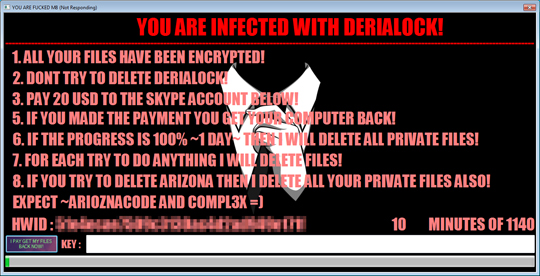RANSOM_DERIALOCK.B
Ransom.DeriaLock (Malwarebytes), Ransom:Win32/Genasom (Microsoft)
Windows


Threat Type: Trojan
Destructiveness: No
Encrypted: No
In the wild: Yes
OVERVIEW
Downloaded from the Internet
This Trojan arrives on a system as a file dropped by other malware or as a file downloaded unknowingly by users when visiting malicious sites.
It connects to certain websites to send and receive information.
TECHNICAL DETAILS
468,992 bytes
EXE
Yes
26 Dec 2016
Terminates processes, Connects to URLs/IPs, Displays graphics/image, Displays message/message boxes
Arrival Details
This Trojan arrives on a system as a file dropped by other malware or as a file downloaded unknowingly by users when visiting malicious sites.
Process Termination
This Trojan terminates processes or services that contain any of the following strings if found running in the affected system's memory:
- taskmgr (Task Manager)
- procexp (Process Explorer)
- procexp32 (Process Explorer 32)
- procexp64 (Process Explorer 64)
- regedit (Registry Editor)
- msconfig (System Configuration)
- utilman
- cmd (Command Prompt)
- explorer (File Explorer)
- certmgr (Certificate Manager Tool)
- control
- cscript (Command-based script)
Other Details
This Trojan connects to the following website to send and receive information:
- http://{BLOCKED}acode.bplaced.net/HF/SystemLocker/unlock-everybody.txt
- http://{BLOCKED}acode.bplaced.net/HF/SystemLocker/UNLOCKKEYS/{Generated HWID}.txt
It renames encrypted files using the following names:
- {filename}.deria
NOTES:
This ransomware avoids encrypting files that contains the following strings in its filename:
- desktop.ini
- .deria
It encrypts files found in the following folders:
- C:\Users\{user name}\My Documents
- C:\Users\{user name}\My Music
- C:\Users\{user name}\My Pictures
- C:\Users\{user name}\Downloads
- C:\Users\{user name}\Desktop
- D:\
It displays the following window after its encryption routine:

It displays the following window that describe what happen and how to restore the encrypted files. It asks for 20 USD for ransom payment:

It displays the following window if the user tries to close the above window:

SOLUTION
9.800
12.940.03
26 Dec 2016
12.941.00
27 Dec 2016
Step 1
Before doing any scans, Windows XP, Windows Vista, and Windows 7 users must disable System Restore to allow full scanning of their computers.
Step 2
Note that not all files, folders, and registry keys and entries are installed on your computer during this malware's/spyware's/grayware's execution. This may be due to incomplete installation or other operating system conditions. If you do not find the same files/folders/registry information, please proceed to the next step.
Step 3
Identify and terminate files detected as RANSOM_DERIALOCK.B
- Windows Task Manager may not display all running processes. In this case, please use a third-party process viewer, preferably Process Explorer, to terminate the malware/grayware/spyware file. You may download the said tool here.
- If the detected file is displayed in either Windows Task Manager or Process Explorer but you cannot delete it, restart your computer in safe mode. To do this, refer to this link for the complete steps.
- If the detected file is not displayed in either Windows Task Manager or Process Explorer, continue doing the next steps.
Step 4
Scan your computer with your Trend Micro product to delete files detected as RANSOM_DERIALOCK.B. If the detected files have already been cleaned, deleted, or quarantined by your Trend Micro product, no further step is required. You may opt to simply delete the quarantined files. Please check this Knowledge Base page for more information.
Step 5
Restore encrypted files from backup.
Did this description help? Tell us how we did.

